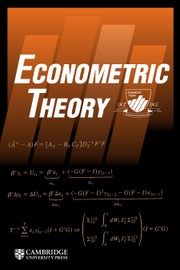Article contents
COVARIANCE MATRIX ESTIMATION AND THE LIMITING BEHAVIOR OF THE OVERIDENTIFYING RESTRICTIONS TEST IN THE PRESENCE OF NEGLECTED STRUCTURAL INSTABILITY
Published online by Cambridge University Press: 24 September 2003
Abstract
We consider the limiting behavior of the overidentifying restrictions test in the presence of neglected structural instability at a single “break point.” It is shown that the test need not be consistent against this type of misspecification. If it is consistent then it emerges that the limiting behavior of this test statistic depends on the covariance matrix estimator employed. In this paper we consider the case in which a heteroskedasticity autocorrelation covariance (HAC) is used. It is shown that (i) if the HAC estimator is based on uncentered autocovariances then the overidentifying restrictions test diverges at rate T/bT where T is the sample size and bT is the bandwidth; (ii) if the HAC estimator is based on centered autocovariances then the rate of increase of the overidentifying restrictions test is either T/bT or T depending on the form of the instability. These results are used to provide conditions for the consistency of the method of moment selection of Andrews (1999, Econometrica 67, 543–564) when certain elements of the candidate set of moments are misspecified as a result of neglected structural instability.This work was begun while Hall was a Senior Research Fellow and Peixe was a graduate student at the Department of Economics, University of Birmingham, UK, and this support is gratefully acknowledged. Peixe also gratefully acknowledges financial support from FCT under Grant PRAXIS XXI/BD/13453/97. We are very grateful for the very useful comments of Don Andrews and two anonymous referees.
Information
- Type
- Research Article
- Information
- Copyright
- © 2003 Cambridge University Press
References
REFERENCES
- 7
- Cited by

